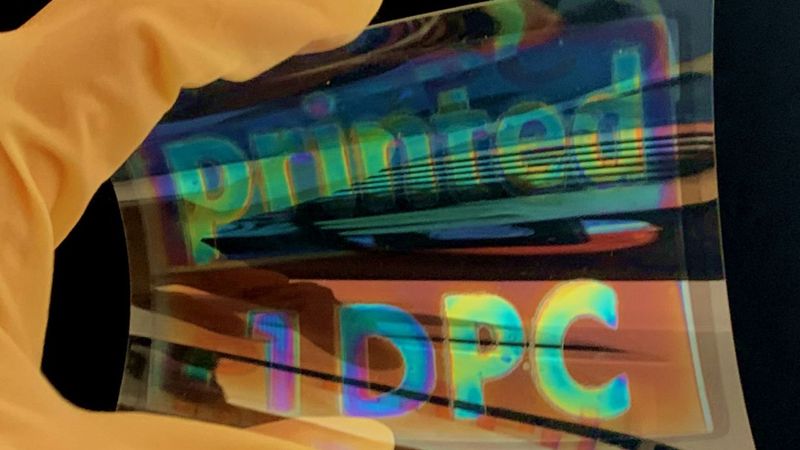Highly reflective mirrors from the inkjet printer
KIT researchers are developing a process with which, for the first time, mirrors with a reflection of more than 99 percent can be printed in variable sizes

Colored, printed mirror layer on a film. Inkjet printing allows structuring so that large-area logos can also be printed (Photo: Qihao Jin, KIT; DOI: 10.1002/adma.202201348)
Dielectric mirrors, also called Bragg mirrors, can reflect light almost completely. This makes them suitable for countless applications, for example in camera systems, in microscopy, in medical technology or in sensor systems. Previously, these mirrors had to be manufactured in expensive vacuum equipment. Researchers at the Karlsruhe Institute of Technology (KIT) have now printed high-quality Bragg mirrors with inkjet printers for the first time. The process could open the way to the digital manufacture of tailor-made mirrors. The results appeared in Advanced Materials ( DOI: 10.1002/adma.202201348 ).
For Bragg mirrors, several layers of material are thinly applied to a carrier. These mirrors, which consist of a large number of thin layers, form an optical mirror that ensures that light of a specific wavelength is reflected in a targeted manner. How strongly Bragg mirrors reflect depends on the materials, but also on how many layers are applied and how thick they are. Previously, Bragg mirrors had to be manufactured using expensive vacuum manufacturing equipment. The Karlsruhe team has succeeded for the first time in printing them on different media. This greatly simplifies production.
Inks made from nanoparticles
"It was a great challenge to develop suitable inks and to establish a reliable process for producing multiple layers," says Professor Uli Lemmer from the Light Technology Institute (LTI) of KIT, who is responsible for the project as part of the "3D Matter Made to Order" Cluster of Excellence. directs. The components of the inks must have suitable optical properties and also be soluble. In addition, each layer should be as even as possible to ensure a consistent stack of layers. In addition, the pressure must be able to be precisely controlled and the results must be reproducible in order to reliably guarantee excellent optical properties, i.e. a high reflectivity of the Bragg mirror. The research team relied on nanoparticles: "Due to the rapid development in nanochemistry, nanoparticles are becoming cheaper and more diverse," says Lemmer. His team used a mix of two different materials, titanium dioxide and polymethyl methacrylate, as optically active components of the inks. Using these inks, they were able to inkjet print the optical properties and thickness of a single layer with extreme precision. "We achieved an ultra-high reflectivity of 99 percent with just ten double layers," says Lemmer. to create the optical properties and thickness of a single layer with extreme precision in inkjet printing. "We achieved an ultra-high reflectivity of 99 percent with just ten double layers," says Lemmer. to create the optical properties and thickness of a single layer with extreme precision in inkjet printing. "We achieved an ultra-high reflectivity of 99 percent with just ten double layers," says Lemmer.
Printing on large and small surfaces
On the one hand, the manufacturing method developed by the researchers at the LTI can be applied to very small areas down to the range of a few micrometers, so that, for example, optical components for microsystems technology or for camera systems can be easily manufactured. On the other hand, large areas such as solar modules, facade elements or advertising displays of a few square meters can also be printed. The mirrors could even be printed on flexible plastic films. “The completely digital manufacturing process allows the production of mirror layers that are precisely tailored to the application. This is an immense advantage compared to previous production processes,” says Lemmer.
original publication
Zhang Q, Jin Q, Mertens QA, Rainer C, Huber R, Fessler J, Hernandez-Sosa G, Lemmer U. “Fabrication of Bragg Mirrors by Multilayer Inkjet Printing”. Advanced Materials 34, 2201348 (2022). DOI: 10.1002/adma.202201348
https://onlinelibrary.wiley.com/doi/full/10.1002/adma.202201348